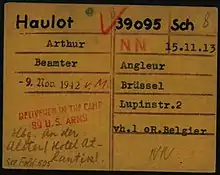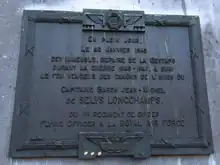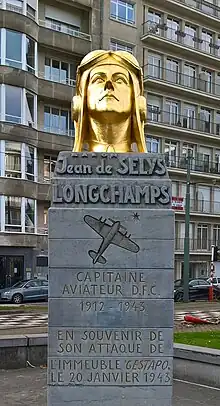Groupe Mémoire - Groep Herinnering (GM-GH) is a Belgian association set up in memory of the Belgian political prisoners of the Second World War.
Purpose
GM-GH has as its main goal to keep alive the legacy and memory of the Belgian Political prisoners and resistance during World War II. The association also favors human rights, and respect for human dignity.[1][lower-alpha 1] The activities of the association include lectures, publications, events, press conferences and educational days.

Historical background
The GM-GH was founded in 1993 by two Belgian resistance fighters and political prisoners of the Second World War,[2][lower-alpha 2] .
Baron Arthur Haulot,[3] then-chairman of Vriendenkring Dachau together with his friend Baron Paul Halter, then-chairman of the Auschwitz Foundation.[4] The founding of the association coincided with the fiftieth anniversary of the liberation of the Nazi extermination camps in 1945. Their successors were (in chronological order): André Wynen[5][6](former president of the World Medical Association WMA) [7] Paul Baeten[8][lower-alpha 3][9] and Yves Louis.
With the death of Philippe Claes and Pieter-Paul Baeten came an end to the era of political prisoners at the helm of the association.[10][lower-alpha 4] The 'children of the second generation' felt there was a need to continue the association's existence and continue the memory of the political prisoners of the Second World War.
.jpg.webp)
Activities
From its inception, the GM-GH has been active in Belgian society at educational and political level.[11]
Educational
In 1995, the GM-GH partnered with the King Baudouin Foundation to set up "50 years later", a memory project intended for Belgian school-goers, both in the Dutch and French speaking regions of the country. The project was under the auspices of the then GM-GH president Haulot. It consisted of a 5-day educational trip by train from Brussels to Auschwitz organized for European youngsters.
The 'Train de la démocratie et de la liberté - Buchenwald - Mittelbau-Dora concentration camp (Allemagne)' (the Train of Freedom to Buchenwald - Mittelbau-Dora concentration camp (Germany)) was an educational sponsored journey which took place in 2008 for 1000 youngsters (400 Belgians and 600 other Europeans) to meet at and learn about the Buchenwald Nazi camp and what transpired there. From the Belgian side, the trip was organized by the National Institute of War Invalids (l'Institut National des Invalides de Guerre, Anciens Combattants et Victimes de Guerre) and the International Federation of Resistance Fighters. Pieter-Paul Baeten accompanied the youngsters on this trip as president of the Buchenwald association and president of the GM-GH.[12][13][14][lower-alpha 5]
The GM – GH organized a symposium entitled “La bioéthique 75 ans après le procès des médecins à Nuremberg” (bio-ethics 75 years after the Nuremberg doctor’s trial). It was held in the Tournai town hall, Tournai, Belgium on 26 November 2022 under the chair of Dr Yves Louis, in commemoration of the 75 years of the doctor’s Nuremberg trial (following the Second World War).[15] The trial consisted of 12 trials for war crimes of high-ranking German officials and industrialists, which took place from 9 December 1946 until 20 August 1947. Twenty of the twenty-three defendants were medical doctors. The symposium speakers dealt with war crimes, the performance of medical experiments, without the subjects' consent, on prisoners of war. Amongst the subjects discussed were the debilitating and cruel genital experiments, the Auschwitz concentration camp block 10 where men and women used as experimental subjects for Nazi doctors. Sterilization was experimented by the injection of a caustic substance into the cervix in order to obstruct the fallopian tubes, attempted X-ray sterilization of healthy men and women in their late teens or early twenties. Thereafter, the removal of the ovaries and testicles for examination. Demonstration of a short film of Alt Rehse village located in north - East Germany. During the Nazi era this was the site of an Institute of Genetics, run by Dr Hermann Boehm, and the Führerschule der Deutschen Ärzteschaft (Leadership School of German Medicine). At this school, doctors, nurses and midwives attended a six-week course, during which they studied Nazi racial ideology, genetics, "racial science" and eugenics. Dr Yves Ternon, a prolific author and historian, gave an account of aktion T4, a campaign of mass murder by involuntary euthanasia in Nazi Germany. He also gave arguments as to how the medical profession Nazified under the third Reich. The symposium also dealt with aspects of the Nuremberg Code and the set of ethical research principles for human experimentation, how these have evolved and adjustments needed as we go forward.
Political engagement
In 2007, Wynen, the second president of the GM-GH, filed a motion before the Senate endorsed by Senator Francis Delpérée stating that in order to be able to stand for democratic elections, all political parties and their candidates must openly declare that their programmes are in conformity with the Universal Declaration of Human Rights adopted on 10 December 1948 by the United Nations and that, should this be challenged, they are prepared to answer before the Belgian judicial system (Breendonk Declaration 2007).
In 2014 the Belgian interior minister Jan Jambon, member of the N-VA party, stated that in his view it was a mistake for the Belgians to collaborate with the German army occupier during the Second World War although these citizens had their reasons for so doing. The GM-GH disagreed with minister Jan Jambon's remarks concerning German collaboration in the Second World War in an article published in La Libre Belgique on 14 October 2014 stating that 'Mr Jambon ought not turn his back on history'.[16]
Parliamentary inquiries
The classification of the cellars of the Gestapo - Avenue Louise, Brussels
During World War II, after the invasion of Belgium, the German military occupied Brussels. The Gestapo, which was part of the Nazi security organisation, the Sicherheitspolizei-Sicherheitsdienst (Sipo-SD), set up their Brussels headquarters on Avenue Louise. On 9 January 2014 the Brussels government launched a procedure to classify the cellars of the buildings occupied by the Gestapo, during the Second World War, at 347 and 453 Avenue Louise in Brussels. The interested parties requesting to preserve this heritage site included Auschwitz Foundation President Henri Goldberg, Daniel Weyssow from the same Foundation and for the GM-GH, Roger de Taevernier and historian Claire Pahaut. The provisional classification obliged the owners to open their cellar to expert investigation by the "Commission royale des Monuments, Sites et Fouilles". Following the favorable report by the "Commission royale des Monuments, Sites et Fouilles" the cellars in the two buildings were officially classified on 14 January 2016.[17][18]


Controversial ongoing allocation of pensions to Belgian military collaborators of the Waffen-SS during the Second World War
Research indicates that a number of Belgians who joined the Waffen-SS during the Second World War received and continue to receive a pension from Germany. At the end of the Second World War, 57,000 Belgians were convicted for collaboration, 30,000 were Flemish and the other 27,000 were Walloons and from the Brussels region.[19] The GM-GH played a pivotal role in lobbying the Belgian government to put an end to German pension payments. The GM-GH voiced concern that former Belgian collaborators were still receiving payments from Germany for their wartime activities.[20] The German government for its part stated in 2012 that it could not confirm the exact number of Belgian ex-collaborators receiving German pensions. They did, however, confirm that 57 Belgians were receiving German BVG ("Bundesversorgungsgesetz") maintenance payments, with no explanation who those Belgians were.[20] Following the work conducted by Alvin de Coninck (son of a resistance fighter) and the GM-GH, deputies from various political parties tabled a motion for a resolution seeking clarification of this issue.[21] As of 2017, 27 people residing in Belgium were receiving this annuity from Germany.[22] A working group will meet under the direction of a representative of the authors of the resolution to submit a proposal to the German authorities.[23][24][25][26] The Belgian parliament's Foreign relations Committee passed a Resolution on 14 March 2019 calling on its government to ask Germany to stop providing this tax-free annuity, whilst emphasizing the injustice of these payments as victims of "Nazism" do not receive comparable allowances.[27][28][29][30]
The Zedelgem Monument
In September 2018, the municipality of Zedelgem, located in the Belgian west Flanders region, erected a monument paying tribute to 12,000 Latvian soldiers of the Waffen-SS fighters of Nazi Germany, imprisoned in war camps in Zedelgem during World War II. The unveiling of the monument was facilitated by the far-right municipal councilor from Vlaams Belang, Pol Denys. The discovery of the monument triggered strong opposition, disapproval and indignation from the GM-GH and other associations.[31] The Groupe Mémoire - Groep Herinnering set itself the task of coordinating the opposition to the existence of this monument with other association members, parliamentarians and historians. In late 2021, a group of historians convened to give advice on the monument. In their opinion, ‘The Latvian Beehive for Freedom’ was far too controversial. The municipal authorities believed the history behind the sculpture had turned out to be more complex than they originally believed. Following a “reflection process,” they decided to follow the experts’ recommendation to dismantle the sculpture, which occurred on May 31, 2022.[32]
Historical projects
Discovery of the Wolvertem Nazi Party Mütterheim
A GM-GH member discovered Nazi documents in the war archives in Paris referring to a Mütterheim (maternity hospital) in Wolvertem, Belgium. This German establishment in rural Wolvertem in Flemish Brabant situated north-west of Brussels was hitherto kept a secret. This Mütterheim was set up by the Germans as a branch of the Brussels Brugmann hospital, which the Germans used as a war hospital (Kriegslazarett). Formerly known as castle Levedale in Wolvertem, referred to also as Neromhof, was converted into a maternity hospital in August 1942. The first admissions were in November of the same year. The Mütterheim offered a good level of medical care for both mother and child. Spouses of SS officers benefited from the facilities offered by this maternity hospital.
The Mütterheim in Wolvertem was by strict definition not a Lebensborn clinic and therefore did not come under the jurisdiction of the SS. A genuine Lebensborn maternity was later established at Wégimont Castle near Liège, the Wolvertem clinic just serving as a stepping stone. Nanna Conti, the mother of the SS minister of public health (Reichsgesundheitsführer) Leonardo Conti,[33] oversaw the Mütterheim in Wolvertem. She appointed a Norwegian Lebensborn as head midwife. Dr. Frans Daels, a gynecologist from Ghent University, and his assistant Adèle Vankerckhove, director of the nursing school in Ghent, saw to the appointment of Flemish midwives to the Mütterheim. The clinic was operational for a year before moving its activities to Wégimont castle, a genuine Lebensborn clinic. An estimated 20 to 30 children were born in Wolvertem.[34][35]
See also
Notes
References
- ↑ In de bijlagen bij het Belgisch Staatsblad bekend te maken kopie na neerlegging ter griffie van de akte [Copy to be published in the appendices to the Belgian Official Gazette after deposit of the deed at the registry] (in Dutch). 31 May 2018.
- ↑ "Le Groupe Mémoire, écouté avant d'être entendu?". La Libre Belgique.
- ↑ "Arthur HAULOT: résistant, poète, haut fonctionnaire et artisan de la mémoire". 26 June 2012.
- ↑ News, Flanders (April 2, 2013). "Auschwitz remembrance pioneer is dead". vrtnws.be.
{{cite web}}:|last=has generic name (help) - ↑ "André Wynen". January 8, 2018 – via Wikipedia.
- ↑ Louis, Yves (2018). "Nouvelle Biographie Nationale" (PDF). Académie Royale de Belgique.
- ↑ Stafford, Ned (15 September 2007). "André Wynen". The Lancet. 370 (9591): 930. doi:10.1016/S0140-6736(07)61432-9. S2CID 54394652.
- ↑ "Un président flamand pour le Groupe Mémoire". La Libre Belgique.
- ↑ "Le Groupe-Mémoire-Groep Herrinering poursuit son action après le décès de son président". RTL Info. February 2018.
- ↑ Laporte, Christian (15 February 2018). "Le Groupe Mémoire poursuit son combat pour la démocratie" (PDF). La Libre Belgique.
- ↑ "Le Groupe Mémoire poursuit son combat pour la démocratie". La Libre Belgique.
- ↑ "Le train de la liberté est parti pour Buchenwald". La Libre Belgique.
- ↑ "10>14 avril 2008 - Train de la Liberté - Buchenwald-Dora (Allemagne) - Province de Luxembourg". province.luxembourg.be.
- ↑ "Christos Doulkeridis - Le train des Mille vers Buchenwald : la jeunesse européenne sur les rails de la liberté et de la démocratie". doulkeridis.be.
- ↑ "75 ans après le procès des médecins de Nuremberg, la bioéthique au coeur des débats à Tournai".
- ↑ Libre.be, La (October 13, 2014). "Monsieur Jambon, ne tournez pas le dos à l'Histoire !". www.lalibre.be.
- ↑ "Dans les caves de la Gestapo". La Libre Belgique.
- ↑ "Fondation Auschwitz - Siège de la Gestapo". Fondation Auschwitz – Mémoire d'Auschwitz ASBL.
- ↑ "Les anciens SS belges touchent toujours une pension de l'Allemagne". RTBF Info. 10 May 2016.
- 1 2 "Belgium ex-Nazis 'get German pensions'". BBC News. 9 June 2016.
- ↑ "Voorstel van Resolutie / Proposition de Résolution" (PDF). Chamber of Representatives (Belgium).
- ↑ "27 Belges reçoivent encore une pension "pour loyauté à Hitler"". 7sur7.be (in French). 2019-02-19. Retrieved 2021-01-02.
- ↑ "27 personnes reçoivent en Belgique une rente allemande après avoir collaboré". Le Soir (in French). Retrieved 2023-01-31.
- ↑ "27 personnes reçoivent en Belgique une rente allemande après avoir collaboré". Le Soir.
- ↑ Vergauwen, Eveline. "Een pensioen voor collaborateurs? 'Ze verdienen dat niet'". De Standaard (in Dutch).
- ↑ Rapport sur la mission afferénte aux pensions octroyées aux anciens collaborateurs millitaires belges (PDF).
- ↑ "Le parlement demande à l'Allemagne de cesser de verser des pensions aux collaborateurs belges". RTBF Info. 14 March 2019.
- ↑ "Germany 'still pays UK and Belgian pensioners who served in SS'". euronews. February 20, 2019.
- ↑ "La France plébiscitée par les investisseurs étrangers" (PDF). Le Monde. Vol. 75, no. 23140. 5 June 2019.
- ↑ Chambre des Représents de Belgique (PDF) (in French).
- ↑ "" Ruche " de Zedelgem : Indignation aux États-Unis, en Allemagne et… en Belgique". 17 June 2021.
- ↑ "Omstreden 'nazi-monument' verhuist naar loods: "Afkoelingsperiode nodig in dit verhit dossier"". www.nieuwsblad.be.
- ↑ Louis, Yves; Verschooris, Marc. "Leonardo Conti et ses rapports avec les médecins belges pendant la Seconde Guerre mondiale" (PDF). pp. 124–136.
- ↑ "De nazi-materniteit van Wolvertem". Canvas (in Dutch).
- ↑ Laprivóte, Gabrielle. Mémoire de Master 2: Implanter le Lebensborn en Belgique, la nationalité ou la « valeur raciale » comme facteur déterminant de son fonctionnement singulier (PDF).